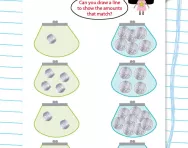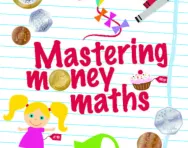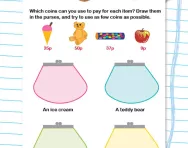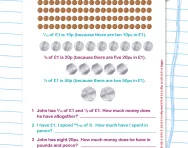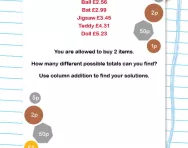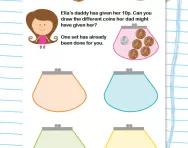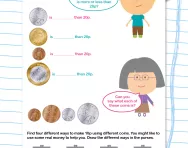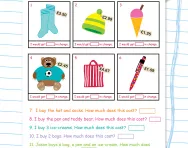TheSchoolRun.com closure date
As we informed you a few months ago, TheSchoolRun has had to make the difficult decision to close due to financial pressures and the company has now ceased trading. We had hoped to keep our content available through a partnership with another educational provider, but this provider has since withdrawn from the agreement.
As a result, we now have to permanently close TheSchoolRun.com. However, to give subscribers time to download any content they’d like to keep, we will keep the website open until 31st July 2025. After this date, the site will be taken down and there will be no further access to any resources. We strongly encourage you to download and save any resources you think you may want to use in the future.
In particular, we suggest downloading:
- Learning packs
- All the worksheets from the 11+ programme, if you are following this with your child
- Complete Learning Journey programmes (the packs below include all 40 worksheets for each programme)
You should already have received 16 primary school eBooks (worth £108.84) to download and keep. If you haven’t received these, please contact us at [email protected] before 31st July 2025, and we will send them to you.
We are very sorry that there is no way to continue offering access to resources and sincerely apologise for the inconvenience caused.
Teachers' tricks for money maths
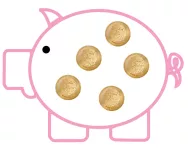
Introduce money from a young age
Even in nursery money often features in role play games. Show your child some real coins and explain to them what the value of each one is. A good game for recognising coins is to put a pile of coins on the table and then give them five seconds to find a certain coin. You could also give them one of each of the different coins and ask them to put them in order, from smallest value to largest.
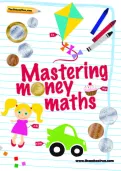
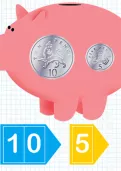
Download FREE money maths resources!
- Mastering money maths workbook
- Year-by-year money maths worksheets
- Teachers' tips and tricks
- Interactive money maths tutorials
Once they are feeling a bit more confident with money, encourage your child's desire to play shop-keeper and help them make the game real by letting them practise paying for items in small shops. Learning the value of each coin takes time, but handling real money will help them get a feel for what each coin looks like and what it's worth. Help them to understand the price of things by giving them a budget (“You can choose a magazine for £3 or less”, for example).
Ignore the £ and p (for now)
In KS1 the money maths objectives focus on simple calculations. When your child has to add or subtract using money, encourage them to understand they can still use tools such as number lines or number squares to help; they can ignore the ‘p’ or ‘£’ units until they come to writing the answer if they want. (They might find it useful to actually see real money relating to the amounts in the calculation to get a concrete view of what is being asked, though.)
At this age, when the amounts they are adding tend to be reasonably small, stick to real rather than toy money whenever you can. Kids love real stuff – money especially! Using real money will make them feel grown-up and will add a imaginative play element to their work.
Practise different ways to make amounts
A key money objective in Key Stage 1 is knowing that there are often lots of different ways to make a given amount. Play a game to demonstrate this by having several purses, each with the same amount in, made up various ways, and get them to spot what you have done. Encourage them to do the same with a different amount.
When you're shopping, model making up the various amounts needed through thinking/counting aloud. So, for example, say, “That’s 85p, so 50p, 20p, 10p and a 5p – 85p in total”.
It is really important that children know how many pence, how many 5ps, how many 10ps, how many 20ps and how many 50ps are in one pound. Again, use real money to demonstrate this, getting them to count out the coins, stopping when they reach 100p. For older children, ask them to investigate every possibility of making a certain amount, for example: 'I want to buy a toy train costing 90p. How many different combinations of 50ps, 20ps and 10ps could make this amount?' Children will need to think about how they can ensure that they have tried every combination. (This may mean some support from you, showing them how to do this in a certain order.)
Find lots of change
Finding change as an objective is introduced in Year 1 and 2.
You’ll first need to check that your child understands what change is and why it is given. Again, with young children, this is best learnt through play, so set up shop and take turns to pay for items with more money than they cost. Encourage them to use subtraction and counting on methods to calculate change. So, for example, if something costs 30p and you pay with a 50p coin, they could count up in tens to see that 20p change is needed. If something costs 7p and you give them 10p, their number bonds knowledge will suggest that 10 - 7 = 3.
Children will also need to become familiar with working out change from £1. Give them a scenario where they want to buy a chocolate bar costing 30p. To calculate their change, they need to work out £1 subtract 30p. They could do this using a number line, or perhaps with ten 10p coins. Continue to practise with various multiples of ten (60p, 20p, 80p, etc.) then move onto other numbers (45p, 67p, 28p, etc.) You can then move on to finding change from notes such as £5, £10, £20, etc.
Use money to explain decimals
As children move into Key Stage 2 money is the ideal unit for practising decimal work. If your child is finding it hard to add 0.10 and 1.78 it can sometimes help to add express the decimals as money (10p and £1.78) to clarify the calculation.
Children need to be constantly reminded that decimals, money and measures are linked, for example:
- 0.25 is a quarter of one
- 25p is a quarter of one pound
- 25cm is a quarter of a metre
- 250g is a quarter of one kilogram
- 250ml is a quarter of one litre
It may help to show them a number line representation of these facts: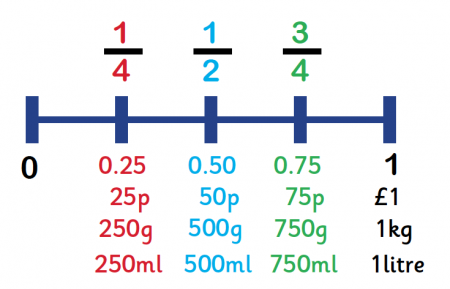
Translate story problems
In Key Stage 2 children work on complex story problems, often with at least two steps to the calculations. When working through word problems you can help by encouraging them to underline key words and amounts that they’ll need for the calculation. A lot of what is written in story problems isn’t needed (for maths purposes, anyway!). So for example:
Raj received £3.45 for his pocket money. His Nana gave him another £2.50 because he’d been good. He spent 58p on chewy sweets.
So the amounts are important, as are words such as ‘gave’ and ‘another’ that indicate ‘more’ (adding) and ‘spent’ (subtracting). Help your child recognise that we only need to know this information to solve the problem – not that the boy is called Raj, that he’s been given some pocket money or that his Nana thought he was good!
If your child finds this problem really difficult, it may help to have some money (real or plastic) to count out the amounts and demonstrate the process of adding and subtracting. They will then need to move onto working out problems like these without using money to help, for which they will need to be confident in written methods for the four operations (addition, subtraction, multiplication and division).
Money maths resources for KS1 and KS2
We love Mintlings, The Royal Mint's collection for free activities for kids. There are interactive games, quizzes, information about coins around the world, design-your-own-coin challenges and lots more resources to explore.
